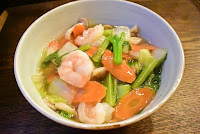Udon often is mentioned as a good choice when feeling unwell. When made with hot, thickened soup, it warms your body from inside. Noodles and warm soup alone is the basic foundation. Ginger -- either grated, finely julienned or only the squeezed juice -- intensifies the warming effect while adding a zesty note and aroma to your soup. Select and cook goodies according to your appetite and condition. While everything is simmered in broth starting with the toughest item below, goodies can be grilled or fried and added to the soup for those who want more texture. This is also a nice dish for chilly days.
The broth's sodium content is on the low end (0.7%), and partly because of the amount of vegetables and mushrooms, it might be too weak for those who have not been on a reduced sodium diet. Adjust the taste to your preferred level at the end.
1/2 of recipe (with virtually sodium-free homemade udon noodles):
480 calories; 22.0 g protein; 3.2 g fat; 87.0 g carbohydrate; 82.9 g net carbs; 651 mg sodium (with 50% reduced-sodium regular soy sauce and shiokoji salted rice malt); 72 mg cholesterol; 4.1 g fiber
<Ingredients>
For broth
600 g katsuo-kobu dashi
1/2 tbsp sake
1 tbsp usukuchi pale soy sauce
1 tsp regular koikuchi soy sauce
1 tsp shiokoji salted rice malt
1 knob ginger
2 tbsp katakuriko potato starch + 2 tbsp water
For toppings
6 shrimp (80g in photo after being shelled, cleaned with potato starch and drained well)
1 small or 1/3-1/2 medium carrot (44 g in photo)
2-3 leaves hakusai napa cabbage (104 g in photo)
Handful saishin yu choy sum (79 g in photo)
Small handful (1/3-1/2 pack) shimeji mushrooms (54 g in photo)
<Directions>
1.
Cook udon noodles (see teuchi udon homemade wheat noodles for method; boiling time varies but method is the same for fresh and dried noodles).
2.
Prepare toppings.
Grate ginger. Slice carrot to desired thickness.
Chop hakusai and yu choy sum. If yu choy sum's stems are thick, cut in half or quarter lengthwise.
Remove root end of shimeji mushrooms.
3.
Put dashi, sake and carrot in a pot, and bring to boil.
Once boiling, reduce heat, and cook until carrot becomes tender (to your preference).
Add shimeji, hakusai and yu choy sum, and cook until done (shimeji becomes somewhat translucent, and yu shoy sum's color turns vivid).
4.
Add usukuchi pale and koikuchi regular soy sauce and shikoji, and heat through.
5.
Add shrimp, and mix.
6.
When shrimp turn opaque/pink, mix potato starch-water mixture again, and add to broth, first 1/2 of the specified amount.
Mix broth and heat through.
Repeat adding potato starch-water mixture until desired thickness is achieved.
Squeeze ginger juice, and mix.
7.
Serve udon (after heating with boiling water) in each bowl, and top with goodies and soup.
Serve immediately.
<Notes>
- Toppings can be as simple as usuage thin deep-fried tofu and sliced green onion. If using usuage, blanch it before use to remove excess oil, which also helps it to absorb flavor of the broth.
- This is also very tasty with somen or hiyamugi thin wheat noodles, both good options when feeling unwell and appetite is low.
- Most store-bought wheat noodles contain sodium, and it could be very high with dried noodles. Boiling with plenty of water (much more water than package instructions) and changing water several times while soaking after boiling significantly reduce remaining sodium.
- The above nutrition figures are based on the assumption that 60% of the broth is consumed. The sodium figure is calculated based on measurement of sodium content of the broth left behind.
- Gomoku means assorted ingredients, and it typically refers to a mixture of vegetables, seafood and meat. Shellfish and squid are commonly used as the seafood component, and chicken or pork is a popular choice as the meat. Our gomoku lacks the meat component.














No comments:
Post a Comment